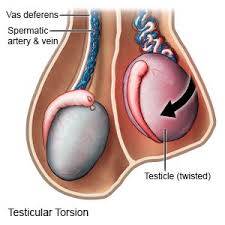Testicular Torsion
Causes
Testicular torsion occurs when the spermatic cord, which supplies blood to the testis, becomes twisted. This can lead to a loss of blood flow and damage to the testicle. Common causes include:
1. Congenital Factors: "Bell clapper deformity," where the testis is not properly attached within the scrotum, allowing it to rotate.
2. Trauma: Injury to the testicles or scrotum.
3. Physical Activity: Sudden movements or strenuous activities may trigger torsion.
4. Sleep: Can occur during sleep due to relaxation of the muscles and spontaneous movement.
5. Age: Most common in males aged 12–18 years.
---
Signs and Symptoms
1. Sudden, Severe Pain: Intense pain in the affected testicle, often without warning.
2. Swelling: Enlargement of the scrotum, sometimes accompanied by redness.
3. Nausea and Vomiting: Common due to severe pain.
4. Abdominal Pain: May occur, especially in younger boys.
5. High Testicle Position: The affected testicle may be higher than usual and oriented abnormally.
6. Loss of Cremasteric Reflex: Stroking the inner thigh fails to cause the testicle to retract.
---
Effects
If left untreated, testicular torsion can lead to:
1. Ischemia: Lack of blood flow can result in tissue death.
2. Testicular Atrophy: Shrinkage of the testis over time.
3. Infertility: Damage to the testis may impair sperm production.
4. Loss of Testicle: Prolonged torsion can necessitate surgical removal of the affected testis.
5. Psychological Impact: Emotional distress from loss or dysfunction of the testicle.
---
Solutions
1. Emergency Surgery (Detorsion): Surgery to untwist the spermatic cord and restore blood flow.
Time is critical: The testicle can usually be saved if treated within 6 hours.
2. Orchiopexy: Surgical fixation of both testes to prevent recurrence.
3. Pain Management: Medications for symptom relief before and after surgery.
4. Removal of Dead Testis: If the testicle is no longer viable, it may need to be removed (orchiectomy).
5. Post-Surgery Care: Follow-up to ensure healing and check for complications.
If you suspect testicular torsion, seek immediate medical attention, as delayed treatment increases the risk of irreversible damage.


